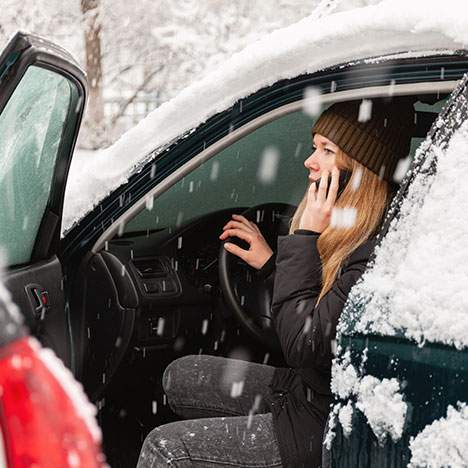Although winter landscapes can be picturesque to observe from indoors, driving in such conditions can be another story altogether. Without warning, roads can turn treacherous due to black ice, strong winds, fallen trees, or heavy snow, and can contribute to winter car accidents. With cold weather set to stick around in much of the United States for several months, it can be helpful to understand the risks involved in winter driving, as well as how accidents in snow and ice often occur. If you’ve been injured while driving in such conditions, contacting a skilled car accident lawyer as soon as possible is an important step toward recovering compensation for your injuries.
Winter Car Accident Statistics
According to the Federal Highway Administration, more than 70% of roads in the U.S. are located in “snowy regions,” meaning they receive more than five inches of snowfall each year. More than 70% of Americans also live in these areas, which means that the majority of Americans deal with winter driving conditions on a yearly basis.
The FHA and the American Highway Users Alliance also note that more than 1,300 people are killed and almost 117,000 injured are in vehicle crashes on snowy, slushy, or icy pavements every year. It is also estimated that snow, ice and fog account for 544 million vehicle-hours of delay each year.
Winter road maintenance makes up roughly one-fifth of state transportation budgets. Between state and municipal agencies, more than $2.3 billion is spent each year keeping snow and ice off the roads. These agencies also spend millions each year repairing damages to road infrastructure caused by something as simple as the freezing and thawing cycles of snow and ice.
What should you do next if you are involved in any car accidents due to snow and ice?
If you find yourself involved in a snowy road accident, the basic steps to take are roughly the same as an accident in good weather and road conditions: move the vehicles to the side of the road if possible; exchange information with the other driver; document the damages and road conditions; and call the police if necessary.
If your car is undriveable and it’s extremely cold out, or conditions are bad enough that police or tow trucks may take some time to reach you, the National Highway Traffic Safety Administration (NHTSA) recommends some extra steps:
- Stay with your car and don’t exert too much energy.
- Make your car visible by placing bright markers on the antenna or windows and keeping the interior lights on.
- Avoid carbon monoxide poisoning by ensuring your exhaust pipe is unobstructed, and run your car only when necessary to stay warm. Don’t run your vehicle for long periods of time with the windows up or in an enclosed space after an accident.
Winter Driving Tips
If you must drive during winter weather, here are some tips provided by the NHTSA for avoiding winter car accidents:

- Slow down.
- Increase your following distance.
- Don’t crowd snow plows or travel beside them.
- Get winter tires and inspect them at least once a month for pressure, age, damage, and tread depth – and don’t forget about your spare tire!
- Dress children who use car seats in thin, warm layers, and place blankets or coats around them for extra warmth. Heavy coats can interfere with the fit of car seat harnesses.
- Get your battery, charging system, and belts checked for needed repairs or replacements.
- Familiarize yourself with your vehicle’s safety technologies.
- Ensure floor mats don’t interfere with your accelerator or brake pedal.
- Check your headlights, brake lights, turn signals, emergency flashers and interior lights.
- Make sure you fill up your windshield wiper fluid reservoir with high-quality “winter” fluid that contains a deicer, and replace worn wiper blades.
- Make sure you have enough coolant in your vehicle, and that it meets manufacturer specifications.
- Check that you have emergency supplies in your car, as well as winter tools like a snow brush and ice scraper.
- Keep your gas tank as close to full as possible — or, if you have an electric vehicle, keep it as close to fully charged as possible.
- Check local weather and traffic reports before heading out and plan your route accordingly.
Who is at fault when involved in car accidents due to icy roads?
Typically, if the vehicle you’re driving slides on ice and collides with another vehicle or object, an insurance company would consider you to be at fault for the accident. Drivers are expected to control their vehicle at all times and to drive safely according to the weather conditions. If you’re going too fast to safely stop, or if you’re following the vehicle ahead too closely, you might not have sufficient grounds to contest fault.
You may feel that a state or municipality should have done a better job of clearing snow off roads and may wish to sue them for negligence. However, most jurisdictions are held to a “reasonable standard of care,” and it’s acknowledged that it’s unrealistic to expect that all roads and sidewalks will be kept in pristine condition all the time. So long as jurisdictions are keeping up a minimum maintenance standard, there’s likely little legal recourse against the state – but there can be exceptions to this.
Finding the Right Attorney for Winter Car Accidents
If you’ve been in an accident in winter road conditions, Avrek Law is here to help you understand your legal options. The consultation is free, and you’ll receive expert advice from a law firm with $1 billion recovered in over 45,000 cases. View our locations and contact Avrek Law for a free consultation -we want to hear more about your case!
